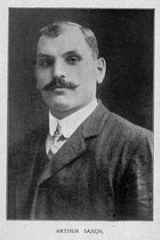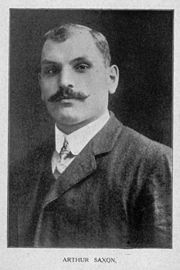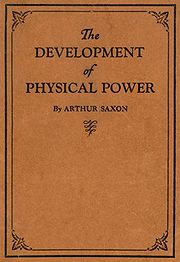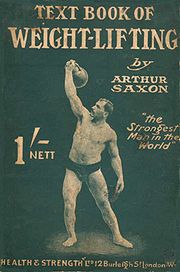
Arthur Saxon
Encyclopedia

Strongman (circus)
The circus strongman is one of many acts found in a modern circus. The strongman demonstrates great strength, power and agility to the audience. The strongman and strongwomen were very popular attractions in the circus in the 19th century....
and circus performer
Circus
A circus is commonly a travelling company of performers that may include clowns, acrobats, trained animals, trapeze acts, musicians, hoopers, tightrope walkers, jugglers, unicyclists and other stunt-oriented artists...
from the late 19th century into the early 20th century. Saxon is most well known for the bent press
Bent press
A bent press is a type of weight training exercise wherein a weight is brought from shoulder-level to overhead one-handed using the muscles of the back, legs, and arm. A very large amount of weight can be lifted this way, compared to other types of one-hand press...
, with which he set a world record of 370 lbs (although there are claims that he has done 385 lbs.) as well as the "two hands anyhow
Two Hands Anyhow
The Two Hands Anyhow is a traditional strongman lift that was popular with lifters such as Arthur Saxon and Thomas Inch . The goal was to lift as much weight overhead with two hands in any method as long as you were not assisted by an outside force...
" lift of 448 lbs. Usually, Saxon is depicted with his recognizable mustache.
Career
Arno Patschke, known as Arno Saxon on stage, a performer and former Greco-Roman wrestlingGreco-Roman wrestling
Greco-Roman wrestling is a style of wrestling that is practised worldwide. It was contested at the first modern Olympic Games in 1896 and has been included in every edition of the summer Olympics held since 1908. Two wrestlers are scored for their performance in three two-minute periods, which can...
player from Germany was eager to make money performing strongman acts. He traveled to Leipzig
Leipzig
Leipzig Leipzig has always been a trade city, situated during the time of the Holy Roman Empire at the intersection of the Via Regia and Via Imperii, two important trade routes. At one time, Leipzig was one of the major European centres of learning and culture in fields such as music and publishing...
, Germany
Germany
Germany , officially the Federal Republic of Germany , is a federal parliamentary republic in Europe. The country consists of 16 states while the capital and largest city is Berlin. Germany covers an area of 357,021 km2 and has a largely temperate seasonal climate...
, where he convinced Oscard Hilgenfeldt and Arthur Saxon to join him in creating the "Greatest Strong Show" in the country. Arthur, 19 at the time, was the youngest performer, although already recognized as the most accomplished bent press performer in the world.
Eventually Saxons's two brothers, Kurt and Hermann Hennig joined the group as well, forming the "Saxon Trio," and in 1897, the Trio began performing for a circus in Europe. In one act, Arthur Saxon lifted his seated brothers on a barbell with one arm. Another popular portion of their performances included opening the stage for anyone who challenged the validity of any lift.

Bent press
A bent press is a type of weight training exercise wherein a weight is brought from shoulder-level to overhead one-handed using the muscles of the back, legs, and arm. A very large amount of weight can be lifted this way, compared to other types of one-hand press...
performance Saxon claimed the act could not be repeated by the famous Eugen Sandow
Eugen Sandow
Eugen Sandow , born Friedrich Wilhelm Müller, was a Prussian pioneering bodybuilder in the 19th century and is often referred to as the "Father of Modern Bodybuilding".-Early life:...
. Unbeknownst to Saxon, on February 26, 1898, Sandow, in the audience at the time, accepted the challenge. Sandow was unable to replicate the lift and, in retaliation, took the Saxon Trio to court. In the case Sandow won with a ruling that he had "handled the bell in exactly the same bodily attitude as Arthur", the judge not fully understanding the lift.
Publications

Saxon's The Text Book of Weight-Lifting, published in 1910, includes some psychological explanation of lifting, rather than strict routine. He explains several lifts, such as the famous bent press and continental lifts.
Death
During his service in World War IWorld War I
World War I , which was predominantly called the World War or the Great War from its occurrence until 1939, and the First World War or World War I thereafter, was a major war centred in Europe that began on 28 July 1914 and lasted until 11 November 1918...
, Saxon suffered from malnutrition
Malnutrition
Malnutrition is the condition that results from taking an unbalanced diet in which certain nutrients are lacking, in excess , or in the wrong proportions....
. After the war he tried to continue his strongman act, which conflicted with his unhealthy condition. He grew weaker and developed tuberculosis. Saxon eventually developed pneumonia, causing his death on August 6, 1921, at age 43.

